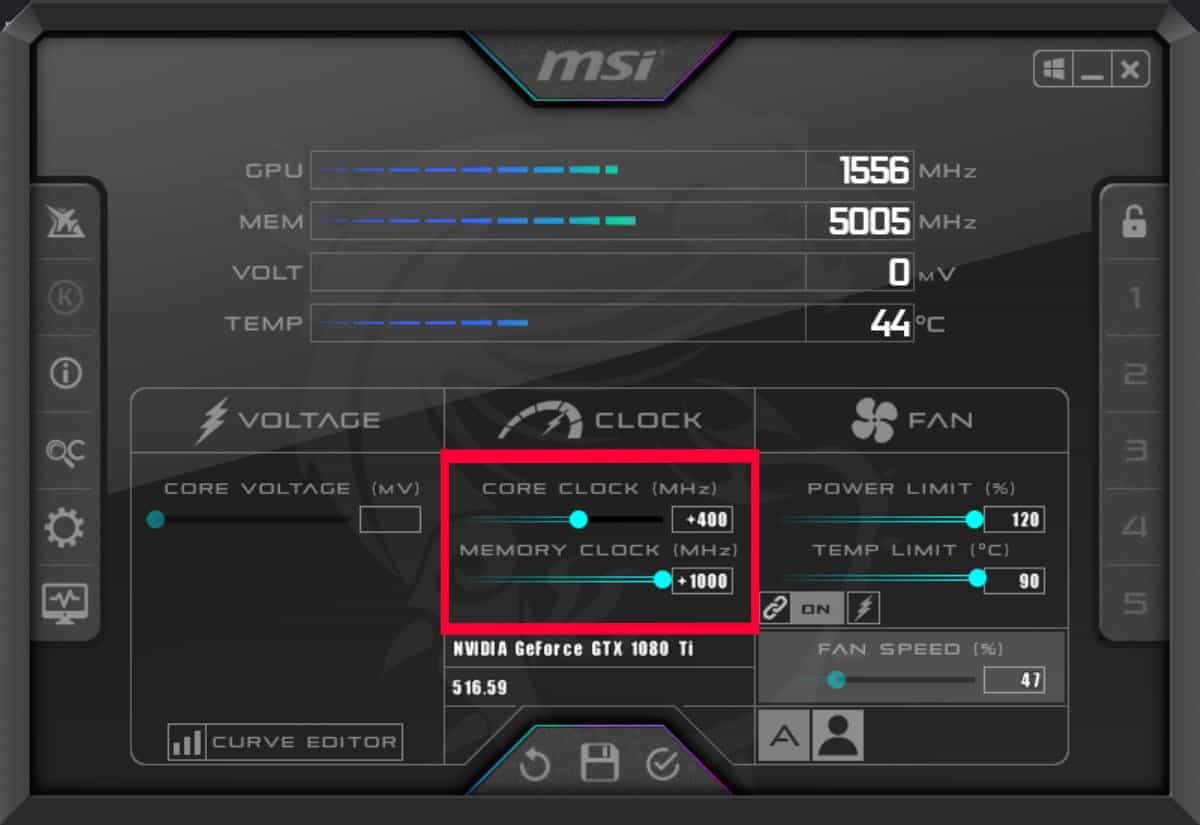

Is my solution correct? Does anyone know how to get it reporting correctly? Thanks. I don't know if AB gets the memory clock and multiplies it by the datarate, or takes the effective clock and divides it by the data rate, but the former would make everything make sense if AB is calibrated to account for quad-pumped GDDR5. That timed by 4 gives me the memory clock given by Afterburner. GPU-Z tells me my memory clock accurately - it's 101MHz idle. 15504 / 2 gives me exactly the max effective memory clock I described above. You get MSI Afterburner, max out power limit, temp limit, and then add 100MHz to your core clock and 200 to your memory. Its octo-pumped datarate gives it an effective memory clock of 15504MHz. My GPU has a max memory clock of 1938MHz. Once Afterburner is installed, open it, go to Settings by clicking the cog icon and check the ‘Unlock voltage control’ and ‘Unlock voltage monitoring’ boxes.

Another words this part of GPU-Z is showing both the correct value and that increases to clock speed via MSI Afterburner are visually doubled from the actual increase being applied (Seems to be showing the theoretical doubling of speed attributed to DDR).GPU: RTX 2080 Super by Zotac (latest driver)Īfterburner (As well as HWMonitor and Zotac's Firestorm) all measure my memory clock speed to hover in idle around 405MHz, and leap into the thousands, often reaching a max of 7750MHz. With these boosted settings, the GPU will now. Does someone maybe know why this is the case and is this even a problem or dangerous I got an MSI GTX 1080 TI, 3440 x 1440 - 120HZ Screen. *I get the feeling MSI Afterburner is applying a theoretical 202MHz which is why only +101MHz is observed in GPU-Z's Graphics Card tab. 1.The first thing you will need to do is set both the ‘Power Limit’ and the ‘Temp Limit’ sliders to the maximum. When im watching youtube videos online about msi afterburner i always see that the clocks are much lower on other people their pc. Core clock (-500) Memory clock (+800) Power limit (73) Fans: auto avg GPU temp - 64.8 avg hotspot. I am unable to tell what is reporting the correct value, everything reports differently. 1 I've tested 2 MSI afterburner profiles (in both i undervolted GPU to 700mV) 1. With VRAM clocks increased by 202MHz in MSI Afterburner the following is observed: Boost Clock / Memory Speed 2595 MHz / 17 Gbps 8GB GDDR6 DisplayPort x 3 (v1. So with VRAM clocks at default the following is observed:Ģ002MHz in GPU-Z Graphics Card tab (correct value) GPU-Z seemingly reports the correct value on the Graphics Card tab. AIDA64 & GPU-Z Sensor tab also shows the VRAM operating at 1901MHz, 101MHz slower than it should be by default. AIDA64 & GPU-Z also shows the GPU not boosting.Īlso various programs seems to be reading the VRAM clock speed incorrectly, MSI Afterburner is showing 3802MHz when it should be 2002MHz or 4004MHz depending on if you're showing actual SDR or theoretical DDR speed.
MSI AFTERBURNER MEMORY CLOCK SOFTWARE
I am on Radeon software version 17.11.2 and Afterburner version 4.4.0. This does not happen for any of the other settings all of which I can change and they will apply successfully. First, we tested the GPU with default settings (+0 Core Clock / +0 Memory Clock) As seen from the picture above, the RTX 2060 hashed at around 28 MH/s with a power consumption of 130 W and runs at 69☌. according to MSI Afterburner and its OSD, my Geforce 1070Ti video card GPU does not boost D: It stays at 1607MHz at all times when it should be boosting to 1683MHz. For some reason I can change all of the settings on the card including memory but when I hit the apply button it just defaults back to 500MHz. You can use MSI Afterburner for overclocking which is one of the most popular tools to overclock GPUs.


 0 kommentar(er)
0 kommentar(er)
